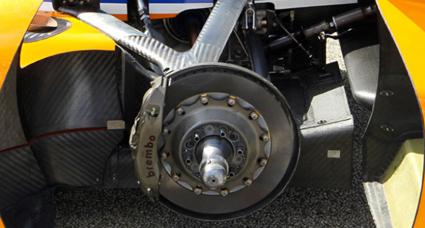Dallara Making Suspension Revision For Toronto
Image

The third instance of the same suspension pieces falling off of the Dallara DW12 chassis since the Grand Prix of Indianapolis on May 10 has led the chassis manufacturer to commission a redesign of the related components.
Team Penske's Will Power, who was running in third place during the final laps of Sunday's Shell & Pennzoil Grand Prix of Houston, was forced to surrender his position after the camber shims in his right-rear suspension fell out, leading the right-rear upright/tire to move in an uncontrolled manner. With the rear of his car often steering the front inside the tight confines of the 1.6-mile street course, Power slowed the No. 12 Verizon Wireless Chevy out of safety concerns, falling to 11th on the final lap.
Penske teammate Juan Montoya and Sarah Fisher Hartman Racing's Josef Newgarden encountered the same issue during the GP of Indy, which utilized tall, aggressive curbing in certain sections. It's believed the Houston layout, which is known for being the bumpiest circuit on the Verizon IndyCar Series calendar, also played a part in the issue that befell Power. The reason behind Team Penske encountering the issue on two of the three occasions is currently unknown.
Teams have been permitted to use slotted camber shims, which are machined washers featuring a groove cut in them to allow faster camber changes. Slotted shims can be installed and removed by loosening the nut that retains the threaded suspension upright clevis, which connects the upper a-arm to the upright. (In simple terms, a solid shim looks like the letter "O," while the slotted versions, with the groove cut to slide over the clevis, look like the letter "C"). If the nut holding the clevis to the upright loosens while on track, or the clevis is bent enough in an impact, the slotted shims could fall out, which happened again at Houston.
Starting at this weekend's 500-mile Pocono event, "teams are required to use solid camber spacers, rather than slotted shims, during the race," according to an update sent to IndyCar teams.
A previous revision to the system was made by Dallara where a tab-and-pin locking method was implemented to secure the shims on the upright. Some teams requested permission to create a locking method of their own, which was denied by the series, citing the need for Dallara to produce uniform updates for the paddock.
Dallara is now working on a revised clevis/camber shim retaining method which could be made available to teams ahead of the next street race in Toronto on July 19-20.
Team Penske's Will Power, who was running in third place during the final laps of Sunday's Shell & Pennzoil Grand Prix of Houston, was forced to surrender his position after the camber shims in his right-rear suspension fell out, leading the right-rear upright/tire to move in an uncontrolled manner. With the rear of his car often steering the front inside the tight confines of the 1.6-mile street course, Power slowed the No. 12 Verizon Wireless Chevy out of safety concerns, falling to 11th on the final lap.
Penske teammate Juan Montoya and Sarah Fisher Hartman Racing's Josef Newgarden encountered the same issue during the GP of Indy, which utilized tall, aggressive curbing in certain sections. It's believed the Houston layout, which is known for being the bumpiest circuit on the Verizon IndyCar Series calendar, also played a part in the issue that befell Power. The reason behind Team Penske encountering the issue on two of the three occasions is currently unknown.
Teams have been permitted to use slotted camber shims, which are machined washers featuring a groove cut in them to allow faster camber changes. Slotted shims can be installed and removed by loosening the nut that retains the threaded suspension upright clevis, which connects the upper a-arm to the upright. (In simple terms, a solid shim looks like the letter "O," while the slotted versions, with the groove cut to slide over the clevis, look like the letter "C"). If the nut holding the clevis to the upright loosens while on track, or the clevis is bent enough in an impact, the slotted shims could fall out, which happened again at Houston.
Starting at this weekend's 500-mile Pocono event, "teams are required to use solid camber spacers, rather than slotted shims, during the race," according to an update sent to IndyCar teams.
A previous revision to the system was made by Dallara where a tab-and-pin locking method was implemented to secure the shims on the upright. Some teams requested permission to create a locking method of their own, which was denied by the series, citing the need for Dallara to produce uniform updates for the paddock.
Dallara is now working on a revised clevis/camber shim retaining method which could be made available to teams ahead of the next street race in Toronto on July 19-20.
 MEMBERSHIP LOGIN
MEMBERSHIP LOGIN JOIN PRI
JOIN PRI


